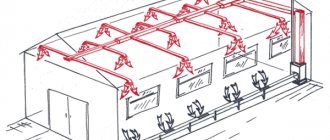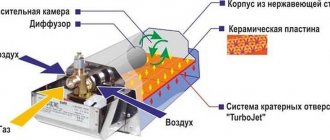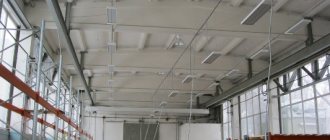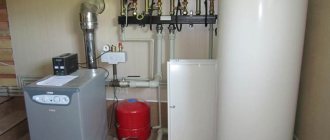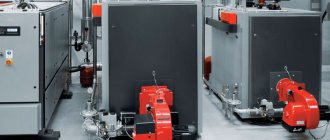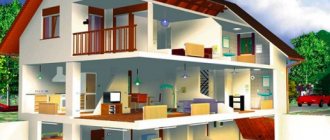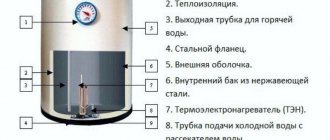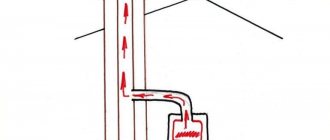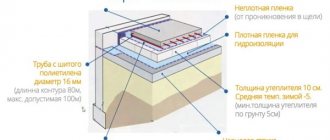How much are they per 1 sq. meter of apartment in 2021?
Heat energy consumption standards are established in each region in accordance with local regulations. For example, as of 2021, in Moscow the norm is 0.16 Gcal per 1 m2 Based on clause. e) clause 4 of PP No. 306, limits are set taking into account:
- materials of walls and roofs of a residential building;
- total area of residential premises;
- area of windows and enclosing structures;
- wear of engineering systems.
Differences in calculations
In general, the calculations include indicators of the total area of residential premises, the area of common property, the volume of thermal energy consumed and the tariff established in the region, per Gcal.
Table taking into account the calculation features:
| Common house metering device (ODPU) | Individual metering device (IMU) | Peculiarities |
| Absent | Absent in all premises | Instead of readings of actual consumption, the standard established in the region is applied, the area of premises in which there are no heat supply devices is taken into account, and for the billing period of 12 calendar months, the frequency coefficient for paying utility bills is applied. |
| Present | Absent in all premises | Services are charged based on the readings of the common house meter, the amount of heat consumption volumes is calculated taking into account the readings of the common house meter. |
| Present | Present in at least one residential area | When calculating the standard, the sums of indications for ODPU and IPU in adjacent apartments are taken into account, the areas of apartments with IPU are summed up, and owners with IPU pay according to individual indications. |
| Present | Present everywhere | The area of the living space is multiplied by the meter readings and the tariff set by the resource supply organization; the ODPU readings are necessary to calculate expenses for general household needs. |
Thus, in houses that are not equipped with metering devices, the standards established in the region are applied. If there is an TDPU or at least one individual subsidiarity, their indicators are taken into account in the formulas.
Similar materials on the company website
Tee press 32 x 1″ HP x 32 ValTec Connecting press tee with external thread. Designed for creating connections of metal-polymer pipes...
Heating systems (water heating) Heating water supply boiler room LLC DESIGN PRESTIGE > https://resant.ru/ Phone We provide...
E-10-4,0-325KB (E-10-4,0-325DWU) - Steam boiler Technical characteristics of E-10-4,0-325KB (E-10-4,0-325DWU) Type: Steam boiler Fuel : coal Nominal steam production,…
Requirements for heat supply systems
The legislation of the Russian Federation imposes sanitary, epidemiological and fire safety requirements for heating systems. For safety reasons, heating devices comply with SanPin and SNiP regulations.
We talked more about the rules for organizing heat supply in a separate article.
Hygienic
- no odor;
- uniform air distribution;
- no toxic emissions during operation;
- accessibility for repairs, cleaning and maintenance;
- absence of noise (what are the causes of noise in radiators?).
The temperature does not exceed 90 degrees. Systems heating above 75 degrees are equipped with protective guards. The concentration of chemicals in the air during operation of heat supply systems does not exceed the established safe exposure level.
Fire protection
Fire safety requirements for the construction and operation of heating systems in apartment buildings are regulated by SP 60.13330.2012. For safety reasons, hot water or steam is used as a coolant. In climatic regions with low temperatures, non-explosive substances are used to prevent the liquid from freezing.
This is important to know: Application to housing and communal services for recalculation of utility bills: sample
In apartment buildings with a height of more than 9 floors, the installation of heat generators operating on gaseous fuel is allowed. Gas supply systems are equipped with automatic systems that shut off the supply of fuel in emergency situations. According to the standards, heat generators are installed in apartments that produce no more than 35 kW of heat. The total heating output does not exceed 100 kW.
Water heating systems for industrial premises
In this case, the heat source can be the local boiler house of the enterprise or even a centralized heat supply. The main element of such a system is a special boiler that runs on gas, electricity or solid fuel. Of course, it is best to choose gas or coal as the latter, but the latter option will be somewhat more expensive. Other types of fuel will cost the organization much more, and therefore it is hardly advisable to use them.
Features of water thermal installations
When using water as a coolant for heating a building, the following features of such systems must be taken into account:
- constant high blood pressure;
- high temperatures;
- are used mainly for moderate heating of objects (the temperature on average should be kept at plus ten degrees), unless, of course, this is detrimental to the production process.
Changes in norms planned in Russia
According to TASS, from 2021 the calculation of the heat consumption standard will depend on the number of floors. The new system was planned to be implemented in 2021, however, at the request of members of the State Duma committee, the project was postponed to 2021. According to the new regulations, the Gcal norm is established depending on the following conditions:
- house material: brick, stone, concrete, wood;
- year of construction: before 1999, after 1999;
- number of floors
According to clarifications from the press service of the Russian Ministry of Construction, the application of new payment conditions will be the right of regional authorities, but not an obligation. As of 2021, the new procedure is not regulated by law, but is already applied in the constituent entities of the Russian Federation, for example, in Krasnoyarsk (Resolution of the Government of the Krasnoyarsk Territory No. 137-p).
Infrared heating
Not every company is ready to spend a lot of money on an air heating system, so many prefer to use another method. Infrared industrial heating is becoming increasingly popular every day.
Principle of operation
An infrared burner operates on the principle of flameless combustion of air located on the porous part of the ceramic surface. The ceramic surface is distinguished by the fact that it is capable of emitting a whole spectrum of waves that are concentrated in the infrared region.
The peculiarity of these waves is their high degree of permeability, that is, they can freely pass through air currents in order to transfer their energy to a certain place. The stream of infrared radiation is directed to a predetermined area through various reflectors.
Therefore, heating industrial premises using such a burner allows for maximum comfort. In addition, this heating method makes it possible to heat both individual work areas and entire buildings.
Main advantages
At the moment, the use of infrared heaters is considered the most modern and progressive method of heating industrial buildings due to the following positive characteristics:
- quick heating of the room;
- low energy intensity;
- high efficiency;
- compact equipment and easy installation.
By performing the correct calculation, you can install a powerful, economical and independent heating system for your enterprise that does not require constant maintenance.
Scope of application
It is worth noting that such equipment is used, among other things, for heating poultry houses, greenhouses, cafe terraces, auditoriums, shopping and sports halls, as well as various bitumen coatings for technological purposes.
The full effect of using an infrared burner can be felt in those rooms that have large volumes of cold air. The compactness and mobility of such equipment makes it possible to maintain the temperature at a certain level depending on the technological need and time of day.
Safety
Many people are concerned about the issue of safety, since they associate the word “radiation” with radiation and harmful effects on human health. In fact, the operation of infrared heaters is completely safe for both humans and equipment located in the room.
Heating of non-residential areas in a multi-storey residential building
To calculate the standard for non-residential premises, for example, staircases, basements, Formula 2 PP No. 354 is used. The total area of the premises is multiplied by the Gcal standard and the tariff established in the region. According to clause 40 of PP 354, payments for utilities in public areas are paid by the owners of residential buildings. Since September 1, 2011, housing and communal services receipts have included a column for general household needs (how are heating fees determined?).
In the absence of individual heating cost metering devices, the standard established by the regional authorities is used for charging. The readings of the common building meter, if available, are taken into account, as well as the area of heated apartments with IPU. Otherwise, residential property owners pay for utilities based on actual resource consumption.
If you find an error, please select a piece of text and press Ctrl+Enter.
Normative base
Ensuring optimal thermal conditions in a room is based on several regulatory documents. Here are the most important ones:
Based on these documents, management companies purchase thermal energy and collect fees from owners to pay for supplies. The provisions are disclosed in more detail in the agreement between the heat supplier and the management company, as well as in the internal instructions of the management company. However, they cannot contradict basic regulatory documents approved at the federal level.
Types of heating in residential buildings
There are many technical schemes designed to ensure optimal temperature conditions in the room. They differ in performance, efficiency, cost and design complexity, and ease of use.
In the most general form, all residential heating systems can be divided into three groups:
- Individual systems provide thermal conditions in one household. Most often, this option is implemented in private homes. For multi-apartment buildings in Russia, such a scheme is exotic, although it is used in some new buildings. Its main advantages are the ability to independently regulate the temperature in the room, finely adjusting to every change in the weather. The disadvantage is the high cost.
- Centralized systems receive heat with a coolant from the main line, and then distribute it among apartments. Most apartment buildings implement just such a scheme. Its advantages are efficiency and relatively low charges for thermal energy. However, it does not allow you to adjust the heat supply to a specific situation, which is why it can be cold in the apartment before the start of the heating season, and too hot when a sudden thaw occurs.
- Autonomous heat supply. In this case, the heat is distributed throughout all rooms of the apartment building, but the energy source is not the supply line from the thermal power plant, but an autonomous boiler house. In most cases, such systems are implemented for industrial buildings or social facilities (schools, hospitals, etc.). In terms of its advantages and disadvantages, this option occupies an intermediate position between the first two options.
But no matter what method is implemented, it must ensure that the temperature regime of the building complies with sanitary standards and regulatory documents in the field of heat supply.
Temperature schedule of central heating supply according to GOST and other laws
The standards require the design of heating systems, as well as the organization of their further operation, in such a way that the air temperature in the premises remains constant throughout the entire heating period, regardless of external conditions. This means that these factors must be taken into account.
The temperature graph shows the relationship between the temperatures of the coolant and the outside air. It is compiled differently for each region, depending on:
- average daily temperatures;
- temperatures of the coldest five-day period;
- other weather indicators (humidity, wind rose, etc.).
In addition, for each system it takes into account:
- type;
- design characteristics of a heated building;
- purpose of premises.
The development of a temperature schedule is necessary not only to maintain comfortable (according to sanitary standards) temperature indicators, but also for a more rational consumption of energy resources.
Today, the temperature schedule is developed individually for each thermal power plant and heating station, depending on the climate zone, equipment, design solutions, and adopted heating schemes. He must ensure compliance with the conditions prescribed in current legislative and regulatory acts, in particular:
- Decree of the Government of the Russian Federation No. 354 of May 6, 2011 “On the provision of utility services to owners and users in apartment buildings and residential buildings.”
- Decree of the Government of the Russian Federation No. 306 of May 23, 2006 “On approval of the rules for establishing and determining standards for the consumption of utility services and standards for the consumption of utility resources for the purpose of maintaining common property in an apartment building.”
- GOST R 51617-2014. Housing and communal services and management of apartment buildings. Public utilities. General requirements.
- SP 124.13330.2012. Heating network.
- SP 131.13330.2012. Construction climatology.
- SP 60.13330.2012. Heating, ventilation and air conditioning.
- SNiP 02/23/2003. Construction heating engineering.
Building regulations
The design of the heating system of a residential building is carried out in accordance with regulatory documentation - GOSTs and SNiPs. The most important of them include:
For your information
There are other standards that are applied taking into account the specific features of the heat supply of a building, for example, when installing a gas heating system. If the heating system of a residential building does not comply with regulatory documentation or cannot provide the required temperature conditions, the building cannot be used for its intended purpose; all disruptions in the operation of communications must be eliminated.
Heating standards in a residential building
A consumer of thermal energy, that is, a homeowner or a person permanently residing in this house, does not need to know all the intricacies of regulatory documentation and the rules for organizing a heating system. But everyone needs to have an idea of what thermal conditions the heating system of a residential building should provide. Here are the basic requirements and rules that apply to residential and utility premises:
- In living rooms, the temperature should be between +20-+22 degrees. A short-term deviation up or down is allowed, but fluctuations of more than 2 degrees are not allowed.
- The temperature in the kitchen and toilet should be 1 degree lower than in living rooms. It is allowed to increase it to +26 degrees, this is due to the use of a gas stove or other heating appliances in the kitchen. But the maximum permissible temperature drop is the same as in residential premises.
- In the bathroom, the temperature level should be higher and be within +24-+26 degrees.
- In corridors and staircases, where a person goes out in warm clothes, the temperature should be within +16-+18 degrees.
This is important to know: Application for debt restructuring for housing and communal services: sample
Additional Information
As practice shows, it is the temperature regime of staircases and flights that is observed the worst - this is due to high heat losses. However, such a violation will certainly lead to cold weather in the apartment, so residents have the right to file a complaint with the Criminal Code.
Features of heating an apartment building
The heat supply system to an apartment building has a number of operating nuances:
- The user's inability to influence the degree of heating of the coolant. All a tenant can do is shut off or reduce the flow to a particular radiator.
- Difficulties with organizing the accounting of supplied heat. It requires installing IPU devices on 2-5 risers, which costs a significant amount for the family budget.
- The start and end dates of the heating season are set without taking into account the opinion of the consumer or natural conditions.
The resident often has to make a lot of effort to create an optimal microclimate. It is required to ensure good thermal insulation in the apartment, as well as to obtain from the management company to carry out similar work to eliminate heat loss in the entrance and stairwells.
Heat calculation rules
To determine the amount of heat supplied, three different formulas are used; they are presented in Appendix of Resolution No. 354. They are used for the following cases:
- There are no metering devices in the building (there is neither a general nor an individual heat consumption meter), and they cannot be installed due to the design features of the heating system or other objective reasons. The formula is as follows: Pi = Si x NT x T t , where Pi is the fee, Si is the housing area, NT is the established standard for thermal energy consumption, and T t is the accepted tariff. For example, if the housing has an area of 45 sq. meters, the region has adopted a standard of 0.018 gigacalories per 1 sq. m., and the tariff is 1950 rubles per 1 gigacalorie, the owner will have to pay 1579.50 rubles if only the period of operating heating is paid.
- A common meter (GPU) is installed in the house, but individual metering devices are missing or not installed in all rooms. The formula is as follows: where V d is the reading of the general building meter, Si is the area of a specific apartment, Sob is the total area of premises in the building, and T T is the current tariff. For example, if a common household device counts 170 gigacalories per month, the area of an apartment is 45 sq.m., the total area of premises in an apartment building is 7100 sq.m., and the regional tariff is 1950 rubles per gigacalorie, then after calculation using the formula the owner will have to pay 2101, 06 rubles. Heat calculations are taken into account only for the heating season.
- The house has both OPU and IPU installed. The calculation formula is as follows: . It contains Vi n - the readings of individual or general metering devices, - heat costs for general house needs, - the area of the apartment, - the total area of the premises, - the established tariff.
Using the last formula, the calculation will be carried out as follows. For example, an apartment meter for a month of heating showed 1.2 Gkl, a common building meter - 65 Gkl, all the heating units in the house showed a total of 53 Gkl. 65 – 53 = 12 Gkl – consumption for general house needs. The total area of premises in the house is 6000 sq.m., the area of the apartment is 62 sq.m. In the region, the tariff is 1600 rubles. for 1 Gkl. After calculating using the formula, it turns out that in just one month of the heating season, the apartment owner will pay 2118.40 rubles.
The management company is required to measure the supplied heat energy monthly using installed meters. But the energy supplier determines the monthly payment once a year.
Calculation of heating radiators in a private house. Calculation of the number of radiators in a private house
If for apartments it is possible to take the average parameters of heat consumption, since they are designed for standard room dimensions, then in private construction this is incorrect. After all, many owners build their houses with ceiling heights exceeding 2.8 meters, in addition, almost all private premises are corner, so heating them will require more power. In this case, calculations based on the area of the room are not suitable: you need apply the formula taking into account the volume of the room and make adjustments by applying coefficients for reducing or increasing heat transfer. The values of the coefficients are as follows:
- 0.2 - the resulting final power number is multiplied by this indicator if multi-chamber plastic double-glazed windows are installed in the house.
- 1.15 – if the boiler installed in the house operates at its capacity limit. In this case, every 10 degrees of heated coolant reduces the power of the radiators by 15%.
- 1.8 is the magnification factor that needs to be applied if the room is corner and has more than one window.
To calculate the power of radiators in a private house, the following formula is used:
P = V x 41, where
- V – volume of the room;
- 41 – average power required to heat 1 sq. m of a private house.
Calculation example If you have a room of 20 sq. m (4x5 m - the length of the walls) with a ceiling height of 3 meters, then its volume is easy to calculate: 20 x 3 = 60 W. The resulting value is multiplied by the power accepted by the standards: 60 x 41 = 2460 W - this is how much heat is required to heat the area in question. Calculation of the number of radiators comes down to the following (taking into account that one radiator section emits 160 W on average, and their exact data depends on the material from which the batteries are made): 2460 / 160 = 15.4 pieces. Let's assume that a total of 16 sections are needed, then There is a need to purchase 4 radiators of 4 sections for each wall or 2 of 8 sections. At the same time, one should not forget about the adjustment coefficients.
Heating payment rules
Clause 42.1 of Resolution No. 354 offers two ways to pay for thermal energy:
- During the period when the heating is on.
- All year round, throughout the year.
At the same time, the choice of payment method or changing one method to another is the prerogative of the government authority in the constituent entity of the Russian Federation. Neither local governments, nor a collective meeting of residents, nor the management company can, by their own decision, change the payment calculation system.
The decision to change the method can be made only once a year, until the first of October. If a decision has been made to introduce year-round payment, it comes into force on July 1 of the following year. If it was decided to charge a fee at the beginning of the heating season, the effective date of the decision coincides with the start date of the heating season next year.
1. Rules for the technical operation of thermal power plants.
Developed and approved by the Ministry of Fuel and Energy of the Russian Federation. No. 115 dated March 24, 2003
clause 9.2 Heating, ventilation, air conditioning, hot water supply systems.
Hydraulic tests of equipment at heating points and heating systems should be carried out separately. Heating points and heating systems must be tested at least once a year, with a test pressure equal to 1.25 working pressure at the heating network inlet, but not less than 0.2 MPa (2 kgf/cm2).
9.2.11 To protect against internal corrosion, heating systems must be constantly filled with deaerated, chemically purified water.
9.2.12 Tests for the strength and density of system equipment are carried out annually after the end of the heating season to identify defects, as well as before the start of the heating period after repairs are completed.
clause 9.2.13 tests for strength and density of water heating systems are carried out at test pressure, but not lower than:
— Elevator unit, water heaters for heating systems, hot water supply - 1MPa (10kgf/cm2 or 10Ati.)
- Heating systems with cast iron heating devices, stamped steel radiators - should be taken as 0.6 MPa (6 kgf/cm2 or 6Ati)
- panel and convector heating systems - 1.0 MPa (10 kgf/cm2 or 10Ati).
— For heaters of heating and ventilation systems — depending on the operating pressure established by the technical specifications of the manufacturer.
-The minimum test pressure during hydraulic testing should be 1.25 working pressure, but not less than 0.2 MPa (2 kgf/cm2 or 2Ati). Pipeline tests are carried out in the following order and must be carried out in compliance with the following basic requirements:
- test pressure must be provided at the top point (mark) of the pipelines; the water temperature during testing should be no higher than 45°C, air is completely removed through air venting devices at the highest points;
- the pressure is brought to the working level and maintained for the time necessary to inspect all welded and flanged connections, fittings, equipment, instruments, but not less than 10 minutes;
- If no defects are detected within 10 minutes, the pressure is brought to the test pressure.
The pressure must be maintained for 15 minutes and then reduced to working pressure. The pressure drop is recorded using a control pressure gauge.
Systems are considered to have passed the tests if, during testing:
— no “sweating” of welds or leaks from heating devices, pipelines, fittings and other equipment were detected.
— when testing the strength and density of water and steam heating systems, the drop within 5 minutes does not exceed 0.02 MPa (0.2 kgf/cm2 or 0.2 Ati).
— when testing the strength and density of panel heating systems, the drop within 15 minutes does not exceed 0.01 MPa (0.1 kgf/cm2 or 0.6 Ati).
— when testing the strength and density of hot water supply systems, the drop within 10 minutes does not exceed 0.05 MPa (0.5 kgf/cm2 or 0.5 Ati).
— when testing the strength and density of plastic pipeline systems during a 30-minute drop, the drop does not exceed 0.06 MPa (0.6 kgf/cm2 or 0.6 Ati).
The test results are documented in a Strength and Density Test Certificate.
If the strength and density test results do not meet the specified conditions, leaks must be identified and repaired, and then the system must be retested.
During testing, spring pressure gauges of an accuracy class of at least 1.5 with a diameter of at least 160 mm, with a division value of 0.01 MPa (0.1 kgf/cm2 or 0.1 Atm), are used.
SNiP 3.05.01-85 “Internal sanitary and technical systems”
4.6. Testing of water heating and heat supply systems must be carried out with the boilers and expansion vessels turned off using the hydrostatic method with a pressure equal to 1.5 working pressure, but not less than 0.2 MPa (2 kgf/cm2 (2Ati)) at the lowest point of the system.
The system is considered to have passed the test if, within 5 minutes of being under test pressure, the pressure drop does not exceed 0.02 MPa (0.2 kgf/cm) and there are no leaks in welds, pipes, threaded connections, fittings, heating devices and equipment.
SNiP 41-01-2003 “Heating, ventilation and air conditioning”
4.4.8 Hydraulic tests of water heating systems must be carried out at positive temperatures in the premises of the building.
Heating systems must withstand, without destruction or loss of tightness, a test water pressure exceeding the operating pressure in the system by 1.5 times, but not less than 0.6 MPa. The test pressure value during hydraulic testing of heating systems should not exceed the maximum test pressure for heating devices, equipment, fittings and pipelines installed in the system.
Social reviews Cackl e
Actions in case of non-compliance with heating standards
What to do if the apartment is too cold or too hot? If there is a clear deviation of temperatures from the optimal temperature regime, the tenant can independently or together with neighbors invite management workers to take measurements. The management company must respond to every request from residents, taking measurements upon request.
If contacting the management company did not produce the desired effect and did not lead to an improvement in the situation, the consumer should file complaints with the local housing inspection authorities and Rospotrebnadzor. The last step in the fight for comfortable living conditions is to file a lawsuit against the management company.
This is important to know: New receipt for payment of housing and communal services: sample 2021
SNiP on heating
"1. APPLICATION AREA
These building codes apply to heat supply, heating, ventilation and air conditioning systems in buildings and structures. The standards contain requirements for sanitary, environmental, and fire safety during use, as well as reliability and energy saving requirements for heat supply, heating, ventilation and air conditioning systems of buildings and structures. ..."
"1. APPLICATION AREA
1.1 These building codes establish climatic parameters that are used in the design of buildings and structures, heating, ventilation, air conditioning, water supply systems, and in the planning and development of urban and rural settlements.
1.2 Climatic parameters are presented in the form of tables and schematic maps. ..."
"1.2. These rules establish sanitary requirements that must be observed during the design, reconstruction, construction, and maintenance of operational residential buildings and premises intended for permanent residence, with the exception of hotels, hostels, specialized homes for the disabled, orphanages, and rotational camps.
4.3. The premises of the first floors of residential buildings located in climatic region I must have heating systems for uniform heating of the floor surface. ..."
We ask you to pay attention: it is with a radiant heating system based on ceiling film electric heaters (PLEN) that maximum uniformity of floor heating is achieved.
This standard establishes the microclimate parameters of the serviced area of premises, residential, public, administrative and domestic buildings. The standard establishes general requirements for optimal and permissible microclimate parameters and control methods.
“5.4.1 The heated area of the building should be defined as the area of the floors (including the attic, heated basement and basement) of the building, measured within the internal surfaces of the external walls, including the area occupied by partitions and internal walls. In this case, the area of staircases and elevator shafts is included in the floor area.
The heated area of the building does not include the area of warm attics and basements, unheated technical floors, basement (underground), cold unheated verandas, unheated stairwells, as well as a cold attic or part thereof not occupied as an attic.
5.4.2. When determining the area of the attic floor, the area with a height up to a sloping ceiling of 1.2 m with an inclination of 30° to the horizon is taken into account; 0.8 m - at 45° - 60°; at 60° or more - the area is measured up to the baseboard. ..."
Cold season and heating season
Average temperature and duration of the heating season
The parameters of the external environment taken into account when calculating the thermal performance of a building and the thermal load on the heating system are: outdoor temperature, wind speed, humidity zone in the construction area, solar radiation intensity.
The most significant parameter of the cold period of the year for choosing the heat-protective qualities of external fences and determining the power of the heating system is the outside air temperature.
Principles for determining the regulated level of thermal protection
“a” - Reduced resistance to heat transfer of individual elements of enclosing structures.
“b” - The difference between the temperatures of the internal air and on the surface of the enclosing structures, as well as the temperature value on the internal surface of the enclosure, which should be higher than the dew point temperature (sanitary and hygienic indicator).
“c” - Specific consumption of thermal energy for heating a building, which makes it possible to vary the values of the heat-protective properties of various types of building enclosures, taking into account the space-planning solutions of the building and the choice of microclimate maintenance systems to achieve the normalized value of this indicator.
- prescriptive (regulatory requirements apply to individual elements of the building’s thermal protection: external walls, floors above unheated spaces, coverings and attic floors, windows, entrance doors, etc.):
- consumer (the heat transfer resistance of fences can be reduced in relation to the prescriptive level, provided that the design specific heat energy consumption for heating the building is lower than the standard).
Hygiene requirements must be met at all times. In industrial buildings, design is allowed only according to the prescriptive option.
Consumer approach to choosing the heat transfer resistance of enclosing structures
We propose to choose a prescriptive approach for assessing a building - as it is simpler and more understandable to a non-specialist. Legally, we are not allowed to give such advice, but clients ask us about this.
Responsibility for design errors in construction, poor-quality thermal insulation, etc., lies entirely with the design organization that completed the “illiterate project,” the builders who do not comply with the terms of the project or violate the technology due to their incompetence, the customer who saved on the project, and the competent builders.
Prescriptive approach to choosing the heat transfer resistance of external structures
In residential buildings, the required heat transfer resistance of external fences that are not directly related to apartments: staircases, staircase and elevator halls, heated technical floors and individual premises should be taken according to line 2 - as for public premises.
Features of the approach to choosing the heat transfer resistance of external fences
We draw your attention to the following:
Heat loss through the contact of the foundation with frozen soil is usually assumed to be 15% of the heat loss through the walls of the first floor (taking into account the complexity of the calculation).
Heat losses associated with ventilation usually account for up to 40% of the amount of heat loss from enclosing structures.
If the wall “breathes,” such as a wall made of 25 cm thick timber, then heat returns. This allows to reduce heat losses.
Air heating
Most enterprises during the existence of the Soviet Union used a convection heating system for industrial buildings.
The difficulty in using this method is that warm air, according to the laws of physics, rises, while the part of the room located near the floor remains less heated. Today, more efficient heating is provided by an air heating system for industrial premises.
Operating principle
Hot air, which is preheated in the heat generator through air ducts, is transferred to the heated part of the building. Distribution heads are used to distribute thermal energy throughout the space. In some cases, fans are installed, which can be replaced by portable equipment, including a heat gun.
Advantages
It is worth noting that such heating can be combined with various supply ventilation and air conditioning systems. This is what makes it possible to heat huge complexes, something that could not be achieved before.
This method is widely used in heating warehouse complexes, as well as indoor sports facilities. In addition, this method in most cases is the only possible one, since it has the highest level of fire safety.
Flaws
Naturally, there were some negative properties. For example, installing air heating will cost the owners of an enterprise a pretty penny.
Not only do the fans necessary for normal operation cost quite a lot, but they also consume huge amounts of electricity, since their productivity reaches about several thousand cubic meters per hour.
